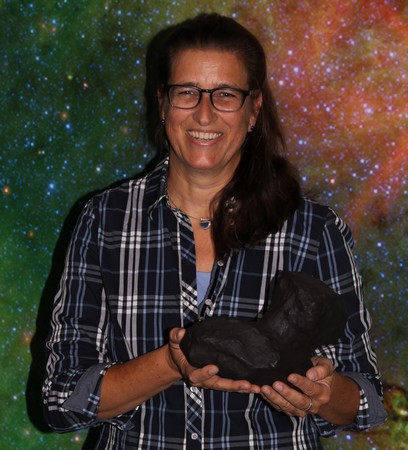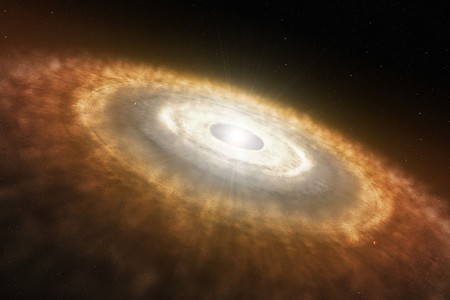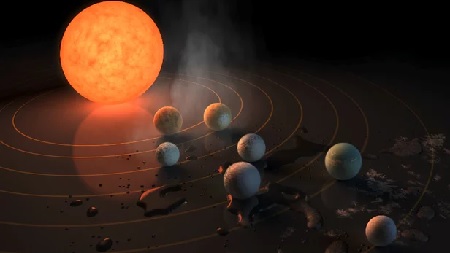Life amongst the stars
There are probably billions of planets out there, but how do we find out if any of them harbour life? University of Groningen astronomy professor Inga Kamp studies planet formation, including the ingredients for life such as water and organic molecules. Part 5 in a series on the Origins Centre, which will investigate how the Universe and life on Earth began.
Hardly a week goes by without a new ‘Earth-like’ planet being discovered. And each discovery gives rise to speculation on whether this planet might harbour life. ‘We will never be 100 percent certain’, says astronomer Inga Kamp. ‘With exoplanets, we must rely on indirect evidence, like signatures of life in the molecules that make up their atmosphere.’

Kamp recently attended a workshop on how to detect such a biosignature. It was part of a series of workshops for scientists linked to the new Origins Centre, which aims to answer questions from the Dutch public on the origin of life, the Universe and our own planet. Together with Paul Mason from the University of Utrecht, Kamp ran the workshop: ‘ Origin and Evolution of Earth-like planets and life’ .
In her research Kamp focuses on the birthplaces of planets, protoplanetary discs or the dust and gas surrounding a newly formed star. Astronomers know that these discs are where planets form. ‘We can’t look through the dust, but by studying patterns in it we can infer a lot about planet formation.’ Kamp uses both observations and simulations to study the structure and composition of protoplanetary discs.
Water
Organic molecules of up to seven atoms in size have been found in protoplanetary discs. ‘But larger molecules are probably present. The problem is detecting them: the larger the molecule, the lower the abundance’, Kamp explains. You need a very high resolution to detect them in a protoplanetary disc, a tiny object by astronomical standards. But complex organic molecules, with dozens of carbon atoms, have been detected in space and comets, so it is safe to assume they are present in protoplanetary discs too.

Another focus of Kamp’s work is water: ‘We want to know how much water is present, and what its source is.’ Very hot water vapour might be present when planets form near a star, which would create an environment suitable for the formation of organic molecules. Asteroids in our own solar system certainly contain water. ‘And we find organic molecules at the water-rock interface.’
Kamp expects that new telescopes such as the Square Kilometre Array (SKA) radio telescope and the James Webb Space Telescope will provide more information on protoplanetary discs and the atmosphere of exoplanets, and reveal the presence of organic molecules in both. The next step will be to interpret them. ‘Many organic molecules are produced by inorganic, chemical processes.’ So just because you discover methane in an alien atmosphere doesn’t mean there is life. ‘We will probably have to look at the relative abundances of different molecules. We can’t do experiments, but can only observe, so it is more like sociological research!’
Creativity
However, direct evidence might be found in our own solar system. New missions to the moons of Jupiter and Saturn are planned, and samples taken from the surface might provide hard evidence for life. ‘The Juno mission has already arrived at Jupiter, and is studying its atmosphere structure and the amount of water. Another mission should launch in 2022.’

Part of Kamp’s work is done ‘in silico’, through computer simulations. Calculating how a protoplanetary disc behaves is quite a challenge. ‘We want to cover a large chunk of the disc over a long period of time, from tens of thousands to hundreds of millions of years.’ The models that Kamp currently uses are not dynamic, as the complexity of the matter exceeds their capability. ‘It requires a lot of creativity, for instance doing a coarse simulation on a large scale and zooming in on regions of interest.’ She needs the help of mathematicians and computer scientists to achieve this.
Money
This is where the Origins Centre comes in: ‘I have met a lot of scientists from different fields, who can help me.’ Some analysis techniques which were developed for other purposes could help her understand chemical pathways in space. ‘I’ve also been talking to Paul Mason and Inge Loes ten Kate, geophysicists from Utrecht University, about how organic molecules may form in rock containing hot water vapour’.’
This is what motivates her, and many colleagues, to attend workshops and meetings organized by the Origins Centre. ‘It is a bottom-up movement. Our aim is to form a community around these very important questions. There may not be much money involved, but by selecting a few key projects for funding, and spending some money on a number of smaller projects such as workshops, we can ensure that the entire Origins Centre community benefits.’
This is the fifth part of a series on University of Groningen research into the origin of life and the Universe.
Part 1: New research centre on the origins of life, the universe and everything
Part 2: Evolving molecules point to principles of life
Part 3: Synthetic biology: building life
Part 4: The mystery of life’s broken symmetry
Part 6: Origins on a computer
| Last modified: | 01 December 2017 3.30 p.m. |
More news
-
10 June 2024
Swarming around a skyscraper
Every two weeks, UG Makers puts the spotlight on a researcher who has created something tangible, ranging from homemade measuring equipment for academic research to small or larger products that can change our daily lives. That is how UG...
-
21 May 2024
Results of 2024 University elections
The votes have been counted and the results of the University elections are in!

